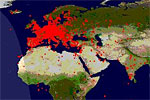


ChessBase 17 - Mega package - Edition 2024
It is the program of choice for anyone who loves the game and wants to know more about it. Start your personal success story with ChessBase and enjoy the game even more.

This year the Linares 2009 tournament is being staged only in Spain – in the previous three years the first half was in Morelia, Mexico, and next year the first half will probably be in the Arab Emirates. The 2009 event goes from February 1th to March 7th, with three rest days. The prize fund is 314,000 Euros, with the winner getting 100,000 Euros, followed by 75,000 and 50,000 Euros for second and third place. There are no appearance fees for the players, so the motivation to fight for points may be unusually high. The venue is el Teatro Cervantes de Linares, the starting time of the games is 16:00h (4 p.m.) Spanish/European time.
Round 4: Sunday, 22 February 2009 |
|||
Teimour Radjabov |
0-1 |
Alexander Grischuk | |
Magnus Carlsen |
½-½ |
Vassily Ivanchuk | |
Vishy Anand |
1-0 |
Wang Yue | |
Levon Aronian |
1-0 |
Leinier Domínguez | |

Carlsen and Ivanchuk played a rare variation of the Gruenfeld Defense, where White achieved a small initiative. At some moment Carlsen’s unjustified refusal to exchange queens handed the initiative over to his opponent. However, the Norwegian didn’t face many troubles to neutralize it and achieve a quick draw.

Radjabov-Grischuk: Radjabov’s creative opening play against Grishuk backfired. The Azerbaijani sacrificed a pawn already on move six in a variation of Queen’s Indian, where White used to go for a similar sacrifice after castling short first. But Radjabov had something much sharper in mind. His king went to the queenside and in a double-edged position he fell a victim to his own over-optimism, which was cleverly used by Grischuk. The Russian grandmaster calmly accepted another pawn sacrifice and then converted his material advantage.

Anand-Wang: Wang Yue is continuing to have visible opening problems with the black pieces. Anand played 1.d4 and was ready to repeat the Slav variation from the earlier game Grischuk-Wang Yue. The Chinese Grandmaster chose a different variation of the Slav, but soon found himself in a slightly worse endgame, where an accurate play from Black was required, which he failed to display. Anand made full use of his opponent’s mistakes and won convincingly.

Almost seven hours work for a single point: GM Levon Aronian from Armenia
Aronian-Dominguez: Aronian also outplayed Domingues in a slightly better endgame resulting right from the opening. The Cuban grandmaster made few inaccuracies rather quickly and was forced to give up a pawn soon, after which in spite of a very long resistance he couldn’t save the game.

Bravely resisted for 92 moves: GM Leinier Dominguez, super talent from Cuba
Carlsen,M (2776) - Ivanchuk,V (2779) [D81]
XXVI SuperGM Linares ESP (4), 22.02.2009
1.d4 Nf6 2.c4 g6 3.Nc3 d5 4.Qb3 dxc4 5.Qxc4 Be6 6.Qb5+ Bd7 7.Qb3 c5 8.dxc5 Bg7 9.e4 Nc6 10.Nf3 Qa5 11.Bc4 0-0 12.0-0 Qxc5 13.Be3 Qh5 14.Be2 Qa5 15.Rfd1 Rfd8
|
16.Nd5. Perhaps a little too aggressive. After 16.h3 Rac8 17.Rac1 White keeps a plus. 16...Nxd5. 16...Nxe4 17.Qxb7 Rab8 18.Nxe7+! Nxe7 19.Qxe4 is slightly better for White. 17.exd5 Ne5 18.a4 Ng4 19.Bd4 Bxd4 20.Rxd4 Qb6 21.Qc3. 21.Qxb6 axb6 22.Nd2 Nf6 23.Ne4 Nxe4 24.Rxe4 Kf8 25.Rb4 Ra5 26.Rxb6 Rxa4 27.Rxa4 Bxa4 28.Rxb7 Rxd5=. 21...Rac8 22.Bc4 e5! 23.dxe6 Bxe6 24.a5. 24.Rxd8+ Rxd8 25.Bxe6 Qxf2+ 26.Kh1 fxe6 favours Black.
|
24...Qxd4 25.Nxd4 Rxc4 26.Nxe6. The only move. 26...Rxc3 27.Nxd8 Rb3 [27...Rc7!?] 28.h3 Ne5 29.Re1 Nc6 30.Nxc6 bxc6 31.Re7 Rxb2 32.Rxa7 Ra2 33.Rc7 Rxa5 34.Rxc6 draw. [Click to replay]
Anand,V (2791) - Wang Yue (2739) [D15]
XXVI SuperGM Linares ESP (4), 22.02.2009
1.d4 d5 2.c4 c6 3.Nf3 Nf6 4.Nc3 a6 5.a4 e6 6.g3 dxc4 7.Bg2 c5 8.dxc5 Qxd1+ 9.Nxd1 Bxc5 10.Ne5 Nd5 11.Ne3. White is not afraid to double his pawns. More important for him is to exchange both Black's developed pieces. In case of the natural 11.Nxc4 Black would have made one more step toward equality by developing another piece – 11...Nc6. 11...Nxe3 12.Bxe3 Bxe3 13.fxe3
|
The doubled pawns on e2 and e3 do not represent a weakness, since Black has other worries than to attack them. What matters is White's pressure on opponent's queenside. Notice also that the open f-file is a plus for White. 13...c3 A new and logical move. Previously Black played 13...Nd7 and 13...Bd7. 14.b4. And a logical answer from the World Champion, who prefers to regain the pawn later on rather than create a weakness on the c-file. 14...Nd7 15.Nd3 Rb8. The Chinese grandmaster prepares the advance of the b-pawn, trying to escape from the pressure on the long diagonal. However, the unusual pawn formation (White's doubled pawns and the extra pawn on c3, which is still alive) required a non-standard solution. Black had to try to exploit opponent's doubled pawns by continuing 15...Nf6! with the idea to prevent the advance of the e-pawn after 16...Ng4 or 16...Nd5. For instance: 16.Rc1 (A move like 16.Bf3 cannot be problematic for Black: 16...Nd5 17.e4 Nf6 18.e5 Nd5 followed by 19...Bd7) 16...Ng4 17.e4 Ne3 18.Bf3 c2 Thanks to the pawn on c2 the lonely knight fights successfully against White's entire army! 19.Kf2 Nd1+! 20.Ke1 Ne3 21.Kd2 Nc4+ 22.Kxc2 (or 22.Kc3 b5 23.Rxc2 Ke7=) 22...e5 and Black equalizes. 16.0-0 b5 17.axb5 Rxb5 18.Rfc1 Ne5 19.Nxe5 Rxe5
|
20.Rxc3. Already here Anand had the possibility 20.b5 The point is that after 20...axb5 (20...Rxb5 21.Bc6+ Bd7 22.Bxb5 Bxb5 23.Rxc3 0-0) 21.Rxc3 0-0 (21...Ke7 22.Ra8 b4 23.Rcxc8 Rxc8 24.Rxc8 Rb5 25.Rc7+ Kf6 26.Be4 is winning for White) 22.Ra8 Bd7 23.Rc7 Rxa8 24.Bxa8 the black bishop is suddenly trapped! 24...Be8 25.Rc8 Kf8 26.Bc6 Therefore after 20.b5 Black must give up the exchange: 20...Rxb5 21.Bc6+ Bd7 22.Bxb5 Bxb5 23.Rxc3 and hope to escape with an exchange down. In such an endgame White's chances to win are usually higher than Black's chances to draw. 20...0-0 21.Bc6 Rd8 22.e4 Kf8 23.Kf2 Ke7. 23...g5 or 23...g6 was necessary, after which the move Kf8-e7 becomes possible. White would have been better, but Black could put up a stubborn resistance. 24.b5! axb5 25.Ra7+
|
25...Kf6. It turns out that after 25...Kf8 26.Rc7 Black has no defence against the threat 27.Rd3 Rxd3 28.Rxc8+ and 29.exd3. That's why Black needed to remove the pawn from g7. In that case Black would have been okay after playing now Kf8-g7, when taking the bishop c8 would have been without check. 26...Ba6 is answered by 27.Ra3; 25...Bd7 loses the piece immediately after 26.Rd3. 26.Rf3+ Kg6 27.Rfxf7. The game is over. And it's not only about the two rooks on the 7th rank, but also about the fact that the bishop c8 has no moves. 27...Rg8 28.Rfc7 Rh5 29.h4 Kf6 30.Ra8 Rc5 31.Rcxc8 Rxc8 32.Rxc8 b4 33.Bd7 1-0. [Click to replay]
Radjabov,T (2761) - Grischuk,A (2733) [E17]
XXVI SuperGM Linares ESP (4), 22.02.2009
1.d4 Nf6 2.c4 e6 3.Nf3 b6 4.g3 Bb7 5.Bg2 Be7 6.d5. The main line is 6.0-0 0-0 7.d5 exd5 8.Nh4 c6 9.cxd5 Nxd5 10.Nf5 Nc7 11.e4. 6...exd5 7.Nh4 c6 8.cxd5 Nxd5 9.Nf5 0-0 10.e4 Nc7 11.Bf4. 11.0-0 would have transposed to the main line, mentioned above. 11...d5 12.Qg4 Ne6 13.Nc3 Kh8 14.Be5 Bf6 15.Bxf6 Qxf6 16.0-0-0!? Nd7 17.f4 Ndc5
|
18.e5. Radjabov overestimates his position. Black has no weaknesses and his king also looks more secure. Therefore it was the right time for White to regain the sacrificed pawn and leave aside his initial ambitions. 18.exd5 cxd5 19.Bxd5 would have kept approximately equal chances. 18...Qg6 19.Qh3. 19.Qxg6 hxg6 20.Nd6 Ba6 21.Kc2 Nb7 is also advantage for Black. 19...f6! 20.Nh4 Qh6 21.Nf3 Qxh3 22.Bxh3 Nc7
|
23.b4?! Black is already better anyway (White's compensation for the pawn is not sufficient), but there is still a lot of play ahead. The best was to bring the last piece into play first - 23.Rhe1 and only in case of 23...Rae8 to continue 24.b4 Now if 24...N5a6 25.b5 cxb5 then White has 26.Bd7 Re7 27.Bxb5 and White is still in the game. 23...N5a6 24.b5. 24.a3 runs into 24...d4 25.Ne4 c5 and white knights on the long diagonal are hanging. 24...cxb5 25.Rhe1 b4 26.Ne2 Bc8 27.Bg2 Bf5 28.Nfd4 fxe5 29.fxe5 Be4 30.Bxe4 dxe4 31.Nf4 Nc5
|
Things became clear: Black is just two pawns up and has everything well protected. 32.h4 Rae8 33.e6 a5 34.Kb1 N7xe6 35.Ndxe6 Nxe6 36.Nd5 Nc5 37.Nxb6 h6 38.Nc4 Rf2 39.Rd5 Na4 40.Rxa5 Nc3+ 41.Ka1 0-1. [Click to replay]
Aronian,L (2750) - Dominguez Perez,L (2717) [D27]
XXVI SuperGM Linares ESP (4), 22.02.2009
1.d4 d5 2.Nf3 Nf6 3.c4 dxc4 4.e3 e6 5.Bxc4 a6 6.0-0 c5
|
7.dxc5. Although this continuation is not the most aggressive way to meet Queen's Gambit Accepted, it is by no means as harmless as it appears. This became clear after the second game of the match Kramnik-Deep Fritz, Bahrain 2002, which was convincingly won by the Russian (the match itself ended 4-4). Generally by playing 7.dxc5 White doesn't really fight for an opening advantage, but just hopes to outplay his opponent in an endgame, which is very close to equal. According to statistics after the mentioned game Kramnik-Deep Fritz, more than 60% of the games ended in a draw. In the remaining games White won twice as many games as Black. 7...Bxc5 8.Qxd8+ Kxd8 9.Nbd2 Ke7 10.b3 Nbd7 11.Be2 b6 12.Ne1 a5 13.Bb2 Rd8 14.a4 Ba6 15.Bxa6 Rxa6 16.Nd3 Ne5. 16...Bd6 followed by 17...Nc5 is preferable. 17.Nxc5 bxc5 18.Bc3
|
18...Rd3. Better was 18...Rad6 with good chances to keep the balance. For instance: 19.Nc4 (After 19.Bxe5 Rxd2 20.Bc3 R2d3 21.Bxa5 Ra8 22.b4 Nd5 23.Rfb1 f5 White is tied up and Black has little to fear.; 19.Ra2 Nc6 20.Nc4 Rd3 21.Rc2 Ra8) 19...Nxc4 20.bxc4 Ne4 21.Bxa5 (21.Bxg7 Nd2!) 21...Ra8 22.Bc7 Rc6 and then 23...Rca6, with equality. 19.Rac1 Ned7 20.e4. Due to the weakness on a5 Black's position is quite unpleasant. On top of that White has an easy plan: 21.Rfe1 and then Kf1-e2. Nevertheless the next move only makes Black's defensive task even more difficult. 20...c4?! [20...Nb8] 21.b4 axb4 22.Bxb4+ Kd8 23.a5 Ne5. 23...Rc6 24.f3 Ne5 25.Rc2 would have hardly saved the pawn either. 24.Nxc4 Nc6 25.Bc3 Nxe4 26.Bxg7 Ke7 27.Rfd1 Rxd1+ 28.Rxd1 f6 29.Bh6 e5 30.Kf1 Nd4 31.Rb1 Rc6 32.Rb4 Nf5 33.Nb6 Nc5 34.Bd2 Na6 35.Rb3 Ke6 36.g4 Nd4 37.Rh3 Rc2 38.Be3 Ra2 39.Rh6 Nc5 40.Nc4 Ra4 41.Nd2 Rxa5 42.Rxh7 Ra4 43.h4 Nd3 44.Rh6 Ra1+ 45.Kg2 Ne1+ 46.Kh3 Ke7 47.Ne4 Nef3 48.Ng3 Ne6 49.Rh7+ Kf8 50.Rh6 Ke7 51.Nf5+ Kf7 52.Rh7+ Kf8 53.Rb7 Ra3 54.Rb6 Kf7 55.Nh6+ Ke7 56.Rb7+ Kd8 57.Nf7+ Ke8 58.Nd6+ Kf8 59.Rf7+ Kg8 60.Rxf6 Nf4+ 61.Kg3 Nd2 62.g5 Nf1+ 63.Kg4 Nxe3+ 64.fxe3 Rxe3 65.Nf7 Re1
|
66.Nxe5 Nd5 67.Rg6+ Kh7 68.Rh6+ Kg7 69.Nf3 Re4+ 70.Kg3 Ne3 71.Rf6 Rg4+ 72.Kh3 Re4 73.Rc6 Nf5 74.h5 Rf4 75.Kg2 Rg4+ 76.Kf2 Kg8 77.Rc8+ Kg7 78.Rc6 Kg8 79.Rb6 Kh7 80.Ra6 Kg8 81.h6 Re4 82.Rf6 Ne3 83.Kg3 Nd5 84.Rf5 Ne7 85.Re5 Rxe5 86.Nxe5 Kh7 87.Kg4 Nd5 88.Nd3 Ne7 89.Nf4 Ng8 90.Kh5 Kh8 91.Nd5 Kh7 92.Nf6+ 1-0. [Click to replay]


Posters for the Super-GM chess tournament hang all around the city

The main street of Linares

Orange trees outside the bull-fight stadium

Southern Spain has citrus fruits, we in Northern Europe have blizzards

A residential area of the town

An outdoor restaurant in the warm sunshine (did we mention our blizzards?)

Carnival in Linares – the little girls show off their beautiful costumes

...and the boys their motorcycle choppers (don't look, it has training wheels!)
You can watch all the games of the Linares Super-GM live on the Playchess server, together with dozens of grandmasters, many of them posting commentary. This is what thinks looked like on Sunday evening:
Server statistics: at 7:40 p.m. there were 8557 visitors on Playchess, and almost 194,000 games had been played. Each red dot represents at least one visitor – most of the dots in the oceans are players entering their geographical coordinated incorrectly. It might interest you to know that Playchess currently has 309,356 registered users, and that the total number of games played so far on the server is 348,375,314 (i.e. over 348 million games). Who says chess isn't booming?
All photos by Nadja Woisin in Linares
|
|
||||||||||||||||||||||||||||||||||||||||
|
|
||||||||||||||||||||||||||||||||||||||||
|
|
||||||||||||||||||||||||||||||||||||||||
|
|
||||||||||||||||||||||||||||||||||||||||
|
|
||||||||||||||||||||||||||||||||||||||||
|
|
||||||||||||||||||||||||||||||||||||||||
|
|
||||||||||||||||||||||||||||||||||||||||
Links
The games are being broadcast live on the official web site as well as on the chess server Playchess.com. If you are not a member you can download the free PGN reader ChessBase Light, which gives you immediate access. You can also use the program to read, replay and analyse the PGN games. |
 |